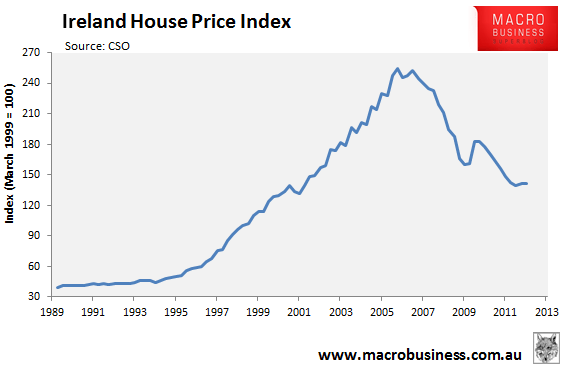
In 2005, the UK’s Policy Exchange released a fascinating research paper describing (amongst other things) Ireland’s dysfunctional urban planning system, whereby the Government granted planning permits too late in response to rising demand, resulting in the building of large numbers of standardised, small, poor quality homes in satellite locations far away from the major cities:
According to Dr Stevenson of UCD Dublin, development for new housing actually took off much too late. “In the early years of the boom, we did not see much building in Ireland”… Because supply was late to meet demand, by the time construction activity actually took off it was too late to deal with the backlog in a reasonable way. All that planners and developers could do was try to satisfy the huge pent-up demand quickly. The result was a quick fix, not a thoroughly reasoned solution…
First, large numbers of flats – something the Irish were not used to – went up, in the form of large apartment-blocks. Second, whole new housing colonies were built, often consisting of hundreds of virtually identical semi-detached or terraced houses lacking any individual character. However, these were often far away from existing amenities, hardly provided any amenities themselves, were poorly built, and served as dormitory towns for existing cities (mainly Dublin). They were also much smaller than comparable houses built twenty or thirty years ago…
To sum up, in the words of Dr Brendan Williams: “The quantity of our supply is very, very good. The quality leaves a lot to be desired”…
Much of the hasty development that Ireland has seen over the past few years could have been avoided if supply had reacted earlier and in a more flexible way to rising demand. But in the early years of the boom, central government had still not realised how important it was to encourage housing development, and local councils, left alone without an independent tax base and lacking the incentives as well as the means to engage in proactive planning, did not plan for enough new houses.
Then, when it was almost too late and prices had already skyrocketed, the government realised the dangers of this situation and encouraged building. But, as Ronan O’Driscoll put it, “the government only thinks in numbers and units” – thus failing to understand that good, flexible and strong supply means more than just “throwing in a few hundred two-storey, three bedrooms semis” (Liam O’Donnell). And this “thinking in numbers” was passed down from central government to local planners, who could basically declare that they had done their jobs properly if they could only show that their numbers had gone up. The quality of these developments does not appear in the statistics and is hard to quantify anyway.
And the outcome of Ireland’s restrictive urban planning regime was summarised by Michael Warby in the March 2011 issue of Quadrant:
In Ireland, local government areas with the highest vacancy rates were the most liberal in releasing land, while the areas with the lowest vacancy rates were the most restrictive. This led to the worst of both worlds, as housing estates were built where they were permitted, rather than where the demand was, while quantity controls in the more desirable areas still drove prices up. The post-bust result is empty estates of unwanted housing.
The rest is history. In the six years to 2012, Ireland’s house prices declined by around 50% (see next chart), wiping-out an estimated €257bn inequity, according to the Irish Independent newspaper:

Over the weekend, The Independent’s Colm McCarthy published a brilliant article explaining how the land-use system around Dublin, which was modeled on the UK’s Town and Country Planning Act of 1947, helped the housing bubble to form, which along with ridiculously loose credit, created the ingredients for one of the biggest housing busts in history:
Ireland passed its first major piece of land-use planning legislation in 1963, modelled on the UK’s Town and Country Planning Act of 1947. The intentions were laudable, to restrict the construction of unwelcome developments and to empower local authorities to take a more active role in shaping the built environment. There was no desire to screw up the residential housing market, but that is eventually what happened.
Our old friend, the Law of Unintended Consequences, began to impact from the mid-Seventies onwards as house prices in Dublin began to diverge from the national average.
…there was and still is no shortage of land in the greater Dublin area, one of the lowest-density urban areas in Europe. There is, however, a shortage of planning permission – an entirely man-made creature of the planning legislation and its restrictive implementation by the Dublin-area councillors and planning officials.
Before land-use zoning came along, house-builders extended the city by buying up farms on the city’s edge and building at whatever densities the market would support. But as more and more lands were withdrawn from the buildable stock by the planners, prices began to rise and the house-builders moved further away from the city proper.
They eventually washed up, courtesy of the bankers’ credit bubble, offering homes for commuters all over the midlands, in North Wexford and even in the southeast of Co Cavan. In the principal residential suburbs of Dublin an artificial scarcity (of planning permission, not of buildable land) was allowed to develop and prices rose…
The result is expensive houses in Dublin, urban sprawl, long commuting distances and serious problems of housing affordability…
The key policy measure required [in Dublin] is the zoning for residential development of the very large volume of derelict and undeveloped land in the Dublin area. It is quite remarkable that the contribution of restrictive zoning to the house price bubble has been so little acknowledged. Builders chose to depart the city precincts for the midlands not because there was strong natural demand locally but because that was where they could get planning permission. Ireland built too many houses during the bubble but also contrived to build them in the wrong places.
Colm McCarthy’s article summarises beautifully many of the unintended consequences of forced urban consolidation, namely: declining housing affordability; increased susceptibility to boom and bust price cycles; increased urban sprawl as lower income households ‘leapfrog’ the growth boundary and settle in far flung exurban towns where housing is more affordable; and shrinking lot sizes as higher land prices and/or planning rules force developers to ‘pack em in like sardines’ in order to try to maintain some semblance of affordability.
It’s also a shame that, despite being blessed with an abundance of land, Australia’s state governments have failed to learn the lessons from overseas and continue to adopt similarly restrictive planning policies.

